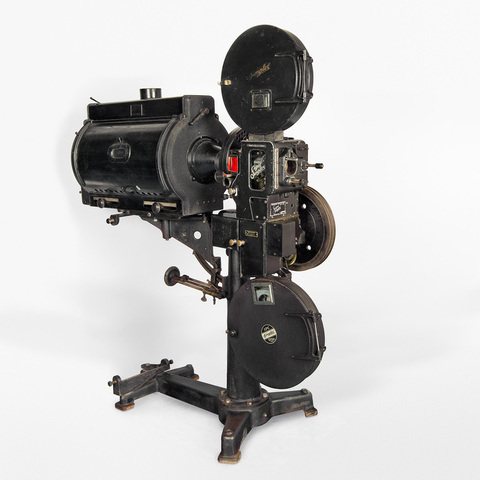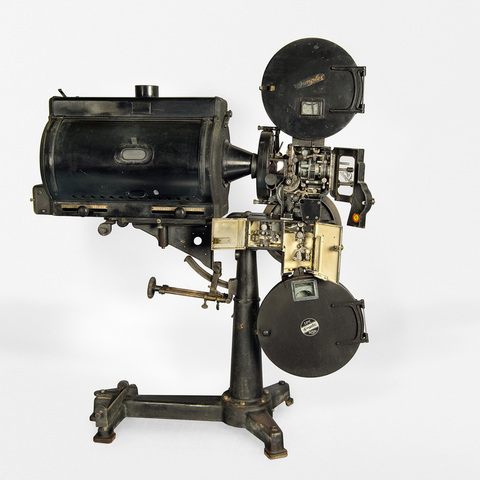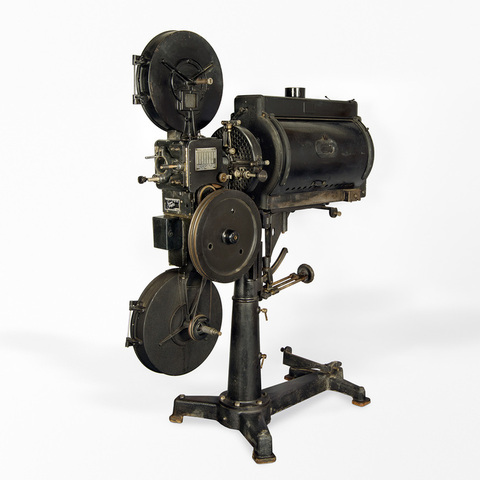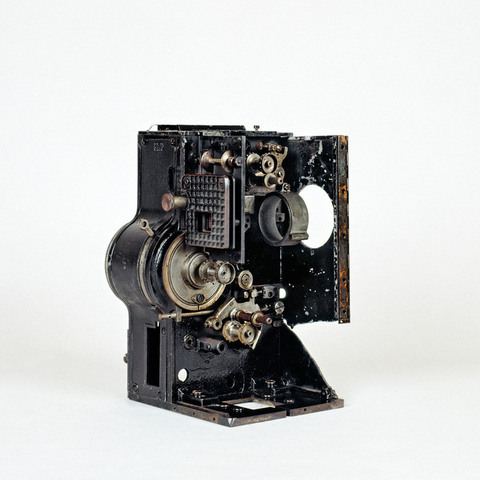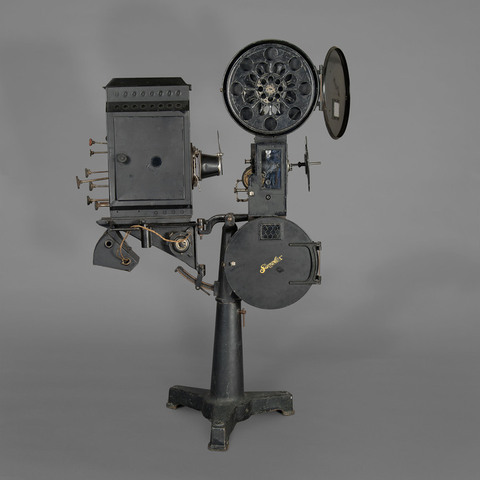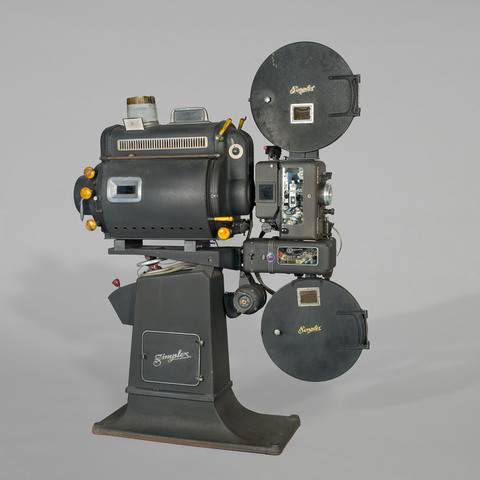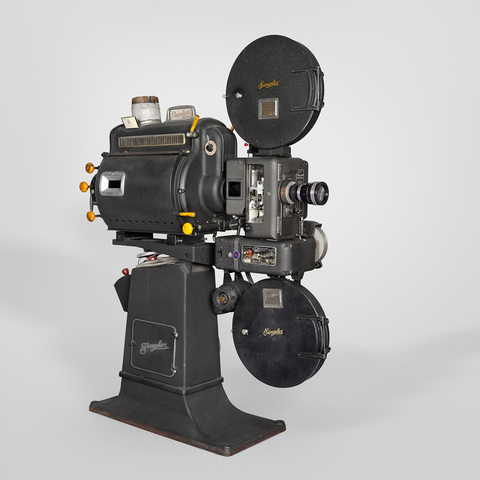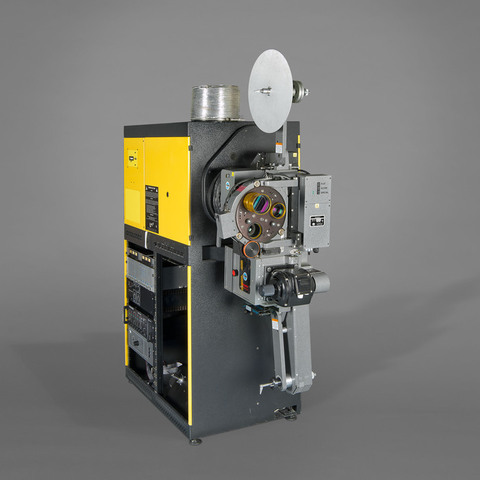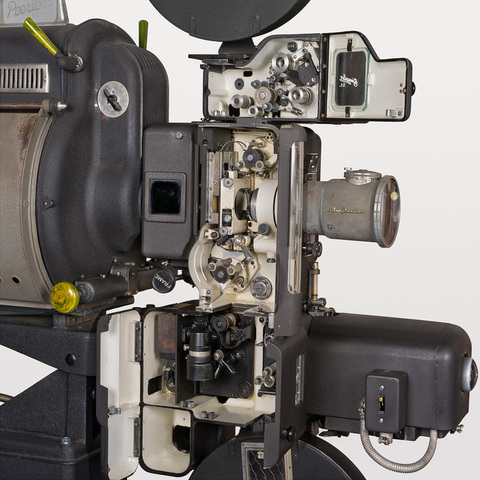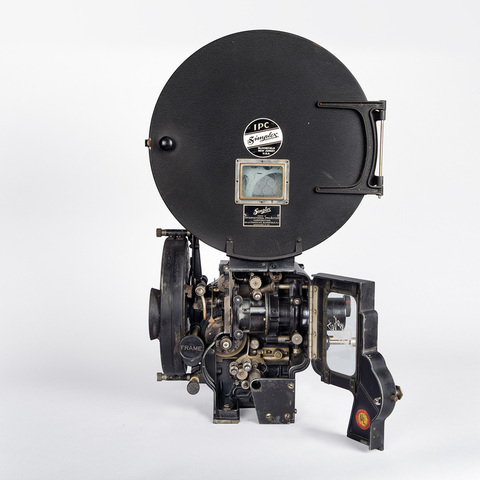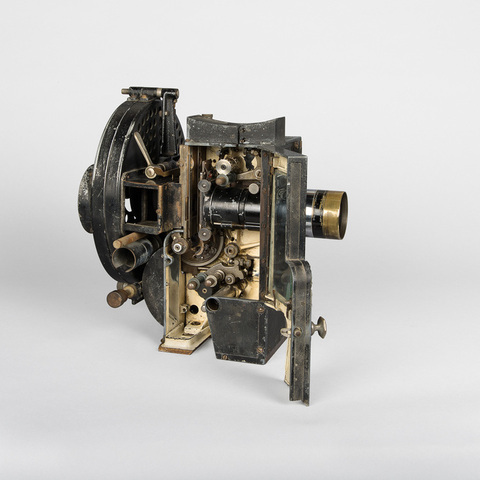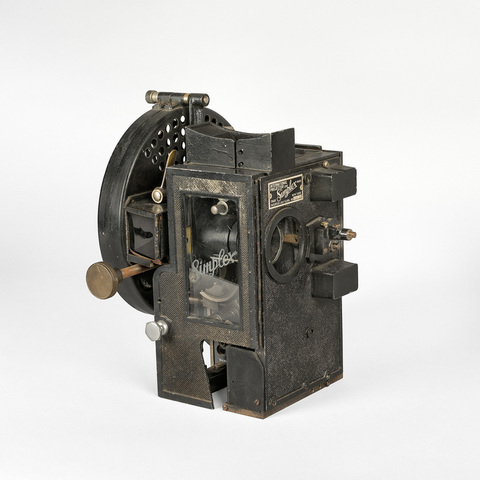Projecteur de film 35 mm sonore
Fiche détaillée
Type de l'appareil
entraînement du film 35 mm sonore par croix de Malte à bain d'huile ; trois débiteurs dentés ; obturateur arrière ventilateur à deux pales réglables sous carter ; volet coupe-feu ; bras débiteur et bras récepteur sous carters ; pied et table réglable en fonte ; lecteur son optique Western Electric 208 B ; lanterne Nurbel à arc électrique et miroir parabolique
Auteurs
Informations non disponibles
Fabricants
Western Electric Co - Electrical Research Products Inc.
Philadelphia
International Projector Corporation
New York, 88-96 Gold Street, New York
Nurbel
Lille, 46 rue Bourignon
Utilisateurs
Informations non disponibles
Distributeurs
Western Electric Co - Electrical Research Products Inc.
Philadelphia
Brockliss-Simplex
Paris, 6 rue Guillaume-Tell
International Projector Corporation
New York, 88-96 Gold Street, New York
Sujet du modèle
Informations non disponibles
Objectif
objectif Hermagis cinéma Paris n° 191 711
Taille de l'objet
Ouvert :
Informations non disponibles
Fermé :
Longueur : 150 cm
Largeur : 60 cm
Hauteur : 177 cm
Diamètre :
Informations non disponibles
Taille de la boîte de transport
Informations non disponibles
Remarques
Marques : "Super Simplex" ; "International Projector Corp. New York Super Simplex n° 47 032. Fabriqué aux Etats-Unis d'Amérique" ; "Fabriqué aux Etats-Unis d'Amérique" ; "Patent notice. Projectors, cameras, parts and accessories therefor manufactured by International Projector Corporation are covered by one or more of the following U.S. Patents : 1 377 727 [...] Des. 04 4 37 and other patents pending. This equipment is sold with the express license restriction that it must be used with parts made by said Company. Violation of this license restrictions will constitue infringement making the user liable to prosecution. International Projector Corporation, 90 Gold Street New York, N. Y. U.S.A. Dec. 13 1937" ; "Western Electric USA 208 B Reproducer Set Patent 1 910 179".
Dépôt du Département de la Charente ville d'Angoulême, 2019, ex-collection René Charles n° 58.
Le premier Simplex a été fabriqué de 1907 à 1924 (CNC AP-97-818). Un deuxième modèle plus évolué suit, de 1925 à 1936. Un troisième modèle (celui-ci) "Super Simplex" (obturateur arrière sous carter) est fabriqué de 1937 à 1946 (voir aussi CNC AP-18-1331). Puis vient le Simplex X-L (AP-12-2760 et 2761).
"Outstanding features... Super Simplex rear shutter : built as an integral part of the Super Simple mechanism. Reduces the heat at the aperture from 50 to 75 % as compared with the old type front shutter. Adjustable revolving shutter : permits adjustment to compensate for wear in the gear train. Patented film trap locking device : prevents film trap door being opened by film patches. Intermittent movement : patented star and cam adjusting feature. Lateral film guide rollers : of large diameter. Revolve very easily. Eliminate possibility of cutting film by roller remaining stationary. Lens holder : has front and rear lens supports and is rigidly attached to the main frame. Removable film trap door and pressure pad assembly. Hardened and ground synchronizing gear shaft. Bakelite micarta gears. Main drive gear fastening screw locking device. Micrometer focusing device on lens mount. Star wheel : this and other parts are hardened and then ground, which gives longer wear and permits finer tolerances than machining soft product and then hardening. Cam and cam pin : quality of material, hardness, workmanship and exact tolerances make this far superior to any similar product, insures quietness and smoothness of operation. Intermittent sprocket : rims and radii of teeth hardened, and ground to almost zero tolerance by specially designed precision machinery. Dynamically balanced flywheel : reduces vibration. Double shutter attachment : sold separately for Super Simplex Mechanism. Outstanding advantages include synchronized front and rear shutters, which create a dissolving effect and give a much sharper picture" (Super Simplex Projector Mechanism, New York, International Projector Corporation, 1940).
"[...] Between 1904 and 1922, Nicholas Power obtained 57 patents covering the design and construction of important improvements in Power's projectors N° 4, 5, 6, 6A, the latter being the last one manufactured. [...] Many other patents were issued to Nicholas Power Co., including a great number covering a complete motion picture projector embodying numerous basic ideas and improvements. The year 1911 saw only two active projector manufacturers ; but beyond the horizon was brewing a storm of formidable proportions, the first faint clouds of which were barely visible. The Simplex projector was on the way. In 1909 two new organisations had entered the field : the Precision Machine Co., which took over the inventions of Francis B. Cannock which were represented by the Edengraph, forerunner of the Simplex Projector ; and the American Motion Picture Machine Co., which developed the Standard projector. The latter company failed in 1913, however, leaving but three surviving projector manufacturers : Nicholas Power, Precision Machine Co., and Enterprise Optical Co. The Precision group lost no time in giving strenuous and persistent battle to Nicholas Power, and after only three years of intensive competition the Simplex projector was firmly established on the market. Thus was established the basis for the famous Power-Simplex feud, with the proponents of each projector proving ready literally at the dropping of a word to vociferously, and often militantly, defend the projector of their choice. The Simplex projector was of entirely different design from the Powers in that is was a considerably more compact mechanism completely enclosed, being on a pedestal of entirely new design and having a great many features which appealed tremendously to the projectionnist. Precision also built up an excellent patent structure covering, among many others, the following salient features : 1) The basic patent covering the entire equipment and including the new framing device by means of which this operation was accomplished by rotating the intermittent casing about the intermittent sprocket axis. 2) A new method of focusing lenses on projectors. 3) An entirely new gate and film-holding structure to maintain the film in the correct optical plane above the intermittent sprocket. 4) Complete enclosures for the mechanism, all prior mechanisms being of the open type with gears exposed. 5) The method of framing the picture in the Simplex mechanism. 6) An improved film-gate door lock, enabling the projectionist to easily close and latch the film-enclosing gate. 7) An entirely new design of fire valve for film magazines. 8) An entirely new type of mechanically-controlled variable-speed device for use with constant speed motors on projectors. The corporate existence of International Projector Corp. dates from 1925 as a result of the merging of Precision Machine Co., Nicholas Power Co., and the Acme Motion Picture Projector Co., with all manufacturing facilities and personnel being concentrated at 90 Gold Street, New York City. This consolidation ushered in a new era of development in projector manufacture, one of the early fruits of which was the Super Simplex mechanism. This projector, while resembling to some extent the older regular Simplex mechanism, embodied many improvements making for better visual projection, greater ease of operation, and considerably more efficient handling of the lens system. A great improvement was made in the intermittent movement by the development at the plant of machinery for manufacturing the operating parts of the movement, that is, the star wheel and cam, and for obtaining far greater accuracies than were obtainable previously. Another major Super Simplex development was the removal of the revolving cut-off shutter to the rear of the projector so that is interposed between the illuminant and the aperture plate. Other Super Simplex improvements involved a new type pad roller arm for accuretely maintaining the film on the sprockets, a threading lamp for quick and accurate framing before projection, and an assembly of enclosures for the entire mechanism. [...] The Regular Simplex mechanism which first appeared as a single-bearing unit and then gave way to the double-bearing alignment. The Super Simple into the manufacture of which was introduced to the trade the practice of hardened-and-ground sprockets. This unit also featured the rear shutter mechanism. The Simplex E17 which included a double shutter and a one-shot oiling system which embraced all moving elements except the intermittent movement. The Simplex E7 which included a double shutter and radical advances as to constitute probably the most important milestone in projector manufacture. On the sound reproduction front, Simplex brought out in 1938 the famous Simplex 4-Star sound system which was the first to utilize permanent magnet speakers. This was followed in 1950 by the radically new design of X-L loudspeakers for use in both enclosed and open-air theatres. In 1954, Simplex scored another notable advance when it made available to the sorely pressed motion picture industry a 4-track magnetic sound reproducer system" (Edward B. Garrison, "Evolution of the Simplex Projector", International projectionist, July 1954, p. 30-44.)
Bibliographie
La Cinématographie française, n° 895, 28 décembre 1935.
La Technique cinématographique, n° 74, février 1937.
Super Simplex Projector Mechanism, New York, International Projector Corporation, 1940.
